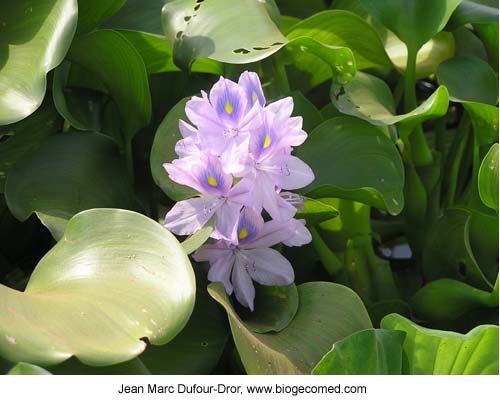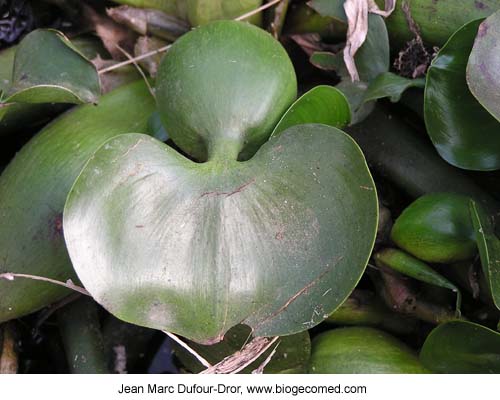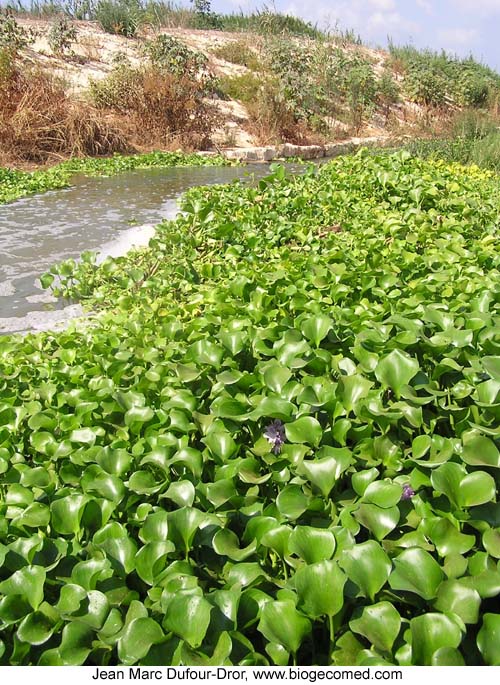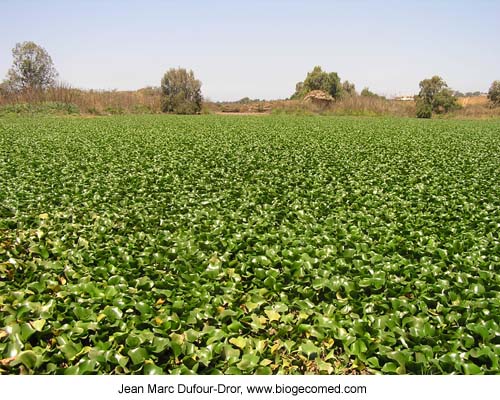|
General
Eichhornia crassipes (Mart.) Solms
Pontederiaceae
Life form: Perennial aquatic
En: Water hyacinth. Fr: Jacinthe d'eau
Provenance: Tropical southern America

Distribution in Israel
Two large and developing populations of Eichhornia crassipes
have been recorded in Israel since 2004: The first is found in
a pond of about 1 Ha nearby Tel-Itshak, and a second population
has developed since 2005 in the Alexander river, northeast to
the city of Netanya. A third emerging population was found in
March 2006 in the Na'aman river, east to the city of Akko (Western
Galilee).

Proliferation status
The water hyacinth in Israel is an 'invasive' alien according
to the terminology suggested by Richardson et al. (2000).
According to the Invasive Species Speciality Group (ISSG) of
the World Conservation Union (IUCN) (Lowe et al. 2000), this plant species is
one of the '100 of the World's Worst Invasive Alien Species'.
Eichhornia crassipes in Israel
The earliest evidence of natural area invasion by the water hyacinth
in Israel is dated to the 1950s when Eichhornia crassipes
infested the Yarkon river near Tel-Aviv.
The species has been introduced in Israel presumably for ornamental
purposes. The possibility that the water hyacinth has been very
recently used in order to cleanse water in aquaculture facilities
near the Alexander river is under investigation.
Though the water hyacinth invaded waterways 55 years ago in Israel,
its resurgence in natural areas seems very recent as it remained
unnoticed until 2004.
The water hyacinth rapidly forms dense mats on the water surface
that crowd out native species. Simultaneously, it modifies water
temperatures and significantly decreases water oxygenation. As
a consequence the biological richness in infested aquatic ecosystems
drops dramatically.
No control programs have been yet developed in Israel in order
to eradicate the two populations that have been recently localized.
However the Ministry of Environment and the Nature and Parks
Authority have been informed and are aware of the threat posed
by the water hyacinth.
Indeed, the very high proliferation rate of the water hyacinth,
coupled with its formidable ability to literally transform the
physical conditions of aquatic ecosystems makes this invasive
one of the most dangerous plant pests in Israel. Should the water
hyacinth continue to proliferate and reach the Hule region, where
vast natural swamps harbor thousands of migratory birds each
year, we will face a major ecological disturbance that may lead
to the collapse of this entire and unique ecosystem recently
restored through tremendous efforts.
A further problem with Eichhornia crassipes in natural
areas in Israel is that winter temperatures, at least in the
coastal plain, do not harm the populations.
The water
hyacinth invading the Alexander River in the Sharon plain (Sept.
11th, 2005)

Control
Mechanical removal can be performed with harvester machines.
Chemical control can be done with the glyphosate formulation
registered for aquatic use. Biological control experiments have
proved effective, particularly with Neochetina species
A pond, south
to the city of Netanya, completely covered by Eichhornia crassipes
(May 26th, 2005)
 . .
References
Guillarmod A.J. (1979) Water weeds in southern Africa. Aquatic
Botany 6:377-391 |
